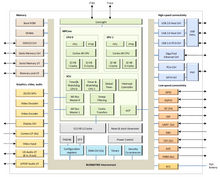System on module
This article includes a list of general references, but it remains largely unverified because it lacks sufficient corresponding inline citations. (December 2016) |


A system on a module (SOM) is a board-level circuit that integrates a system function in a single module. It may integrate digital and analog functions on a single board. A typical application is in the area of embedded systems. Unlike a single-board computer, a SOM serves a special function like a system on a chip (SoC). The device integrated in the SOM typically requires a high level of interconnection for reasons such as speed, timing, bus-width etc., in a highly integrated module. There are benefits in building a SOM, as for SoC; one notable result is to reduce the cost of the base board or the main PCB. Two other major advantages of SOMs are design-reuse and that they can be integrated into many embedded computer applications.[further explanation needed]
History[]
The acronym SOM has its roots in the blade-based modules. In the mid 1980s, when VMEbus blades used mezzanine modules,[1] these were commonly referred to as System On a Module (SOM). These SOMs performed specific functions such as compute functions and data acquisition functions. SOMs were and still are[when?] extensively used by Sun Microsystems, Motorola, Xerox, DEC, and IBM in their blade computers.
Design[]
A typical SOM consists of:
- at least one microcontroller, microprocessor or digital signal processor (DSP) core
- multiprocessor systems-on-chip (MPSoCs) have more than one processor core
- memory blocks including a selection of ROM, RAM, EEPROM and/or flash memory
- timing sources
- industry standard communication interfaces such as USB, FireWire, Ethernet, USART, SPI, I²C
- peripherals including counter-timers, real-time timers and power-on reset generators
- analog interfaces including analog-to-digital converters and digital-to-analog converterss
- voltage regulators and power management circuits
See also[]
References[]
- ^ "IEEE 1386-2001 - IEEE Standard for a Common Mezzanine Card Family: CMC". standards.ieee.org.
- ANSI/IEEE Std 1014-1987 and ANSI/VITA 1-1994
- 1386-2001 - IEEE Standard for a Common Mezzanine Card Family: CMC
- Standard ANSI/VITA 46.0-2007
- VITA Technologies Hall of Fame - PCI Mezzanine Cards
- Microcomputers
- Embedded systems
- Computer buses
- IEEE standards